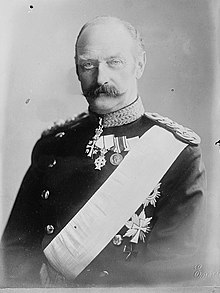This article needs additional citations for verification. (July 2021) |
| Frederik VIII | |||||
|---|---|---|---|---|---|
 Frederik VIII in 1909 | |||||
| King of Denmark | |||||
| Reign | 29 January 1906 – 14 May 1912 | ||||
| Predecessor | Christian IX | ||||
| Successor | Christian X | ||||
| Born | Prince Christian Frederik Vilhelm Carl of Schleswig-Holstein-Sonderburg-Glücksburg 3 June 1843 Yellow Palace, Copenhagen, Denmark | ||||
| Died | 14 May 1912 (aged 68) Hamburg, German Empire | ||||
| Burial | |||||
| Spouse | |||||
| Issue Detail | |||||
| |||||
| House | Glücksburg | ||||
| Father | Christian IX of Denmark | ||||
| Mother | Louise of Hesse-Kassel | ||||
| Religion | Church of Denmark | ||||
| Signature | |||||
Frederik VIII (Danish: Christian Frederik Vilhelm Carl; 3 June 1843 – 14 May 1912) was King of Denmark from 29 January 1906 until his death in 1912.
The eldest son of King Christian IX, nicknamed the Father-in-law of Europe, Frederick was related to royalty throughout Europe. He was heir apparent to the Danish throne and served as crown prince for more than 42 years. During the long reign of his father, he was largely excluded from influence and political power.[1] Upon his father's death in 1906, he acceded to the throne at the advanced age of 62. In many ways, Frederick VIII was a liberal monarch who was much more favorable to the new parliamentary system introduced in 1901 than his father had been, being reform-minded and democratically inclined. Due to his late accession to the throne, however, Frederick's reign would last only six years, throughout which he was plagued by ill health.
Frederick VIII was married to Louise of Sweden, with whom he had eight children. Their eldest son succeeded his father as Christian X of Denmark, while their second son, Carl, ascended the Norwegian throne as Haakon VII in 1905.
- ^ "Frederik (Christian F. Vilhelm Carl) f. 1843, Kronprins". Dansk biografisk Lexikon. Retrieved 1 November 2019.